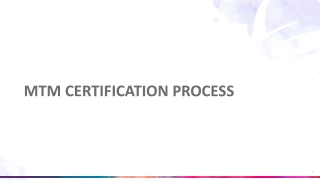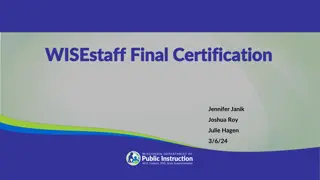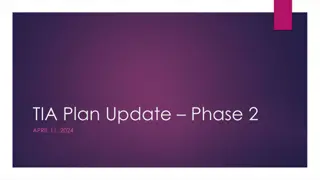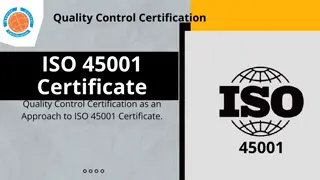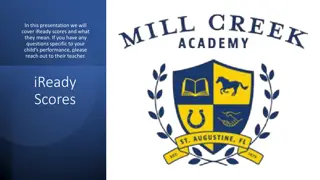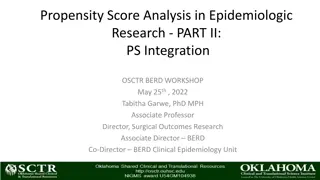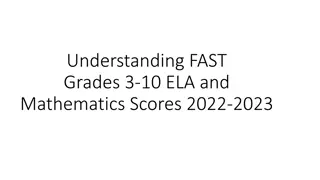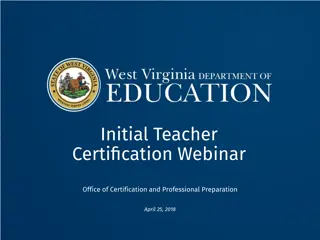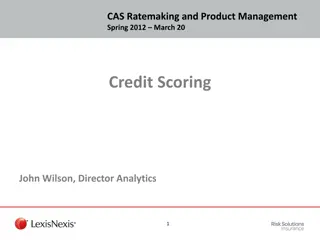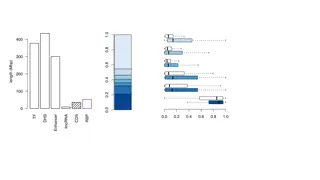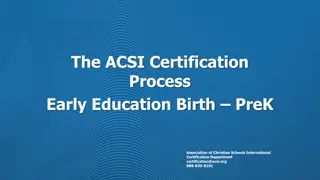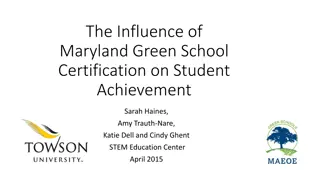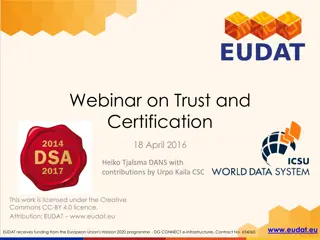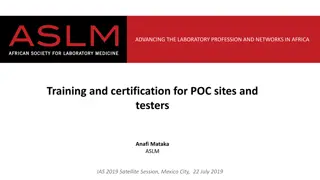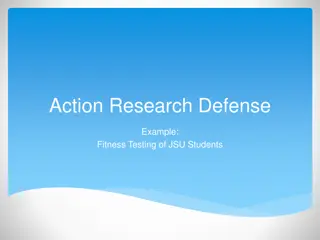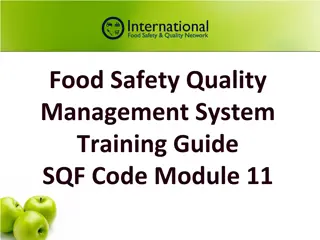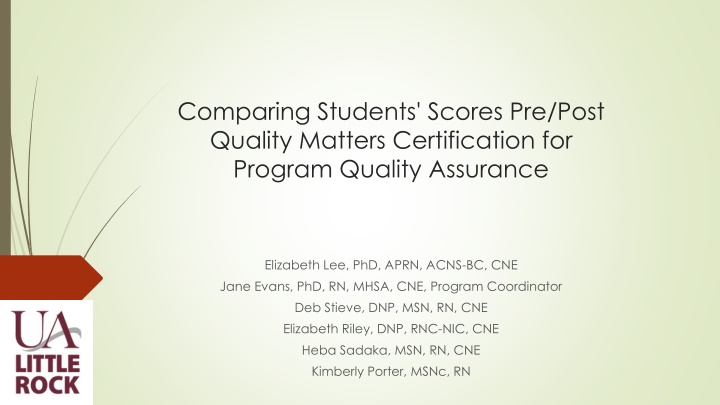
Comparing Students' Scores Pre/Post Quality Matters Certification for Program Quality Assurance
This overview delves into the comparisons of students' scores before and after Quality Matters certification for program quality assurance at the University of Arkansas at Little Rock. It highlights the RN-BSN online program's accreditation, student demographics, faculty awareness, and the strategic plan aiming to enhance student learning experiences.
Uploaded on | 1 Views
Download Presentation

Please find below an Image/Link to download the presentation.
The content on the website is provided AS IS for your information and personal use only. It may not be sold, licensed, or shared on other websites without obtaining consent from the author. If you encounter any issues during the download, it is possible that the publisher has removed the file from their server.
You are allowed to download the files provided on this website for personal or commercial use, subject to the condition that they are used lawfully. All files are the property of their respective owners.
The content on the website is provided AS IS for your information and personal use only. It may not be sold, licensed, or shared on other websites without obtaining consent from the author.
E N D
Presentation Transcript
Comparing Students' Scores Pre/Post Quality Matters Certification for Program Quality Assurance Elizabeth Lee, PhD, APRN, ACNS-BC, CNE Jane Evans, PhD, RN, MHSA, CNE, Program Coordinator Deb Stieve, DNP, MSN, RN, CNE Elizabeth Riley, DNP, RNC-NIC, CNE Heba Sadaka, MSN, RN, CNE Kimberly Porter, MSNc, RN
Session Learning Objectives After this session, participants will be able to 1. describe Quality Matters (QM, 2018) certification/institutional quality assurance initiative alignment 2. compare RN-BSN students scores pre/post QM certification for each course 3. discuss use of QM certification process for faculty development
Facts about the University of Arkansas at Little Rock s RN-BSN Online Program Accreditation Commission for Education in Nursing (ACEN, 2017) accredited ladder program Associate in Applied Science (AAS) to registered nurse to bachelors of science in nursing (RN-BSN) Quality and Safety Education for Nurses (QSEN, 2018) competencies guide our student learning outcomes Current RN-BSN online enrollment 348 students racially and ethnically diverse with the majority being non-traditional, transfer, and military students RN-BSN faculty are culturally-aware (Sharif & Gisbert, 2015) nurse educators Theoretical framework: Adult learning theory (Knowles, 1980) and student focused cognitivism and constructivism (Winstone & Millward, 2012)
UA Little Rocks 2017 strategic plan Objective 2: UA Little Rock will continue to develop and integrate innovation and technology into instruction to enhance the student learning experience. Strategy 3: Implement processes for continually improving educational offerings and measuring their effectiveness. Objective 3: UA Little Rock will ensure student success through excellent academic and co-curricular programs as measured by state, national, and internal measures. Strategy 1: Implement a process for data-informed decision-making for continuous campus improvement.
UA Little Rocks 2017 strategic plan Objective 4: UA Little Rock will enhance opportunities to enrich learning beyond the classroom that lead to civic engagement and lifelong post-graduate success for students. Strategy 2: Increase the number of collaborative relationships between UA Little Rock and external organizations that create learning opportunities for the university s students. Course curriculum incorporates service learning/civic engagement projects and Joining Forces content We care about student success after graduation
Quality Matters at UA Little Rock As part of our mission to provide faculty support for teaching and learning through the use of Blackboard, we have implemented the Quality Matters program at UA Little Rock. The purpose of this program is to contribute to faculty excellence, facilitate student success, and provide a continuous improvement process for courses in Blackboard (Scholarly Technology and Resources, n.d.)
Evolution of QM/QA in RN-BSN program Prior to initiating program wide QM standards, faculty recognized the need to: promote consistency within and among courses for ease of use by student and faculty provide more consistent, reliable objective measures of learner outcomes using more standardized grading rubrics promote faculty and part-time faculty development and satisfaction participate in internal and formal external quality assurance (QA) review of courses for certification design a continuous quality improvement strategy to evaluate individual and collective RN-BSN program courses after certification
Comments pre-QM 2013/2014 Student: I went to nursing school before there were computers and I have found it difficult in the online environment at times I had no idea how to conduct a search for scholarly sources and spent so much time. Thankfully my instructor would take my calls and texts!!.. 2013/2014 Part-time faculty: You have to do something to fix this course; it is unorganized and confusing Listened how online courses were labor intensive for students and faculty Created a task force to address student concerns Created strategies for student and part-time faculty areas for improvement on progression reports each part of term
Advantages offered by QM standards Integrates with Blackboard quality learning management system for multiple online sections and courses (Bates, LaBrecque, & Fortner, 2016) Standardizes template development shell for course content which is valuable to working students with time obligations (Youger & Ahern, 2016) Improves consistency among course coordinators or part-time faculty/coaches Stimulates consistency in grading rubrics with standardized penalties for late submissions Offers mode for faculty development with clear standards for grading responses and feedback to students Provides a measure of course/program quality
Multiple sections of 100% online RN-BSN courses NURS 3310 Professional Role Development NURS 3420 Wellness Promotion and the Nurse Educator NURS 3430 Health Care Economics NURS 3440 Research and Evidence Based Practice NURS 3350 Ethics, Legalities, and Advocacy NURS 4415 Nursing Practice: Community Health Needs NURS 4420 Nursing Practice: Leadership and Management NURS 4430 Nursing Practice: Integration of Concepts
Measuring the impact of QM Strategies used for meeting challenges to measuring the impact of QM suggested by Legon (2015): Focus on courses that do not meet QM standards initially but only after revision Evaluate course retention, dropout rates, grades, and overall satisfaction Conduct research projects encompassing programs, departments, and institutions collecting data on learner performance and attitudes over time Compare several terms of results before and after course revision
Quality Assessment Initiative We asked What is the difference in students scores before and after Quality Matters certification for the eight core courses of an online Bachelor of Science in Nursing (BSN) program? Used pretest/posttest design with independent t-test analysis for 6 courses and Chi-square for 2 Compared pre/post student total scores three semesters before and three semesters after QM certification for the eight core RN-BSN courses Explored the risk of decrease in student scores with the increased QM rigor in courses against the benefit of program wide consistency in quality
Semesters for pre/post testing by course Pre-certification semesters Post-certification semesters Coordinator Course Date QM certified Pre1 Pre2 Pre3 Post1 Post2 Post3 Jane Evans N3310 Sp14 Su14 Fa14 Sp15 Su15 Fa15 3-27-15 Jane Evans N3420 Fa14 Sp15 Su15 Fa15 Sp16 Su16 10-23-15 Kimberly Porter N3350 Su15 Fa15 Sp16 Su16 Fa16 Sp17 6-23-16 Elizabeth Riley N3430 Sp16 Su16 Fa16 Sp17 Su17 Fa17 4-21-17 Elizabeth Lee N3440 Fa14 Sp15 Su15 Fa15 Sp16 Su16 8-19-15 Deb Stieve N4415 Fa16 Sp17 Su17 Fa17 Sp18 Su18 9-22-17 Heba Sadaka N4420 Su15 Fa15 Sp16 Su16 Fa16 Sp17 7-18-16 Elizabeth Lee N4430 Fa14 Sp15 Su15 Fa15 Sp16 Su16 9-22-15
Results: Student Scores Independent t-tests Course Total scores Highest point project NURS 3350 Ethics, Legalities, & Advocacy t(381)=0.865; p=0.387 t(381)=44.048; p=0.000 NURS 3430 Health Care Economics t(329)=4.654; p=0.000 t(312)=1.729; p=0.085 NURS 3440 Research & Evidence Based Practice t(332)=1.350; p=0.178 t(317)=2.056; p=0.041 NURS 4415 Community Health Needs t(402)=0.328; p=0.743 t(400)=1.857; p=0.064 NURS 4420 Leadership and Management t(352)=1.959; p=0.051 t(356)=0.13; p=0.990 NURS 4430 Integration of Concepts t(264)=2.654; p=0.008 t(302)=1.455; p=0.147
Results: Student Scores Chi-Square Course Chi-square student grades NURS 3310 Professional Role Development 2 (3, n=400)=0.756; p=0.860 NURS 3420 Wellness Promotion & the Nurse Educator 2 (3, n=382)=3.152; p=0.369
Comments post QM certification 2018/2019 Student: course was well organized and well constructed which allowed me to differentiate between evidence- based research types as well as analyze the findings. 2018/2019 Part-time faculty: I have been previewing the course and I am very excited about the content. I am currently teaching evidence based practice in the NP program at xxx University I find myself wishing those students had been privileged to this course.
Discussion QM standards provided guidance for alignment by creating direct links from student learning outcomes to learner activities to grading rubrics to student scores (Legon, 2015) More active learning group work with formative scaffolding (Winstone & Millward, 2012) Learner outcomes Lower student satisfaction scores similar to Swan et al. (2012) Need strategies to increase student retention rates (Dietz-Uhler, Fisher, & Han, 2007; Glazier, 2017) Student grades can provided information for areas of improvement We analyzed student scores as a quantitative measure of learner outcomes program wide Fulfilling ongoing data-driven decisions expectations at our institution
Limitations: different faculty, part-time faculty or coaches, and students Multiple different faculty were required to obtain QM certification for each course, such as for NURS 3430: 2014 content created by Kathy was placed by Elizabeth into a QM-based developmental shell and loaded the syllabus template created by Sean in STaR 2014-2017 course coordinator Jamie iteratively refined content, assignments, and rubrics with the help of multiple part-time faculty and feedback from students; underwent internal review twice before submission to QM for external review 2017 returned to Elizabeth to be used for faculty development to orient newcomer Riley to the QM process Different students pre/post QM certification required larger sample size over several semesters Different sections of courses graded by part time faculty and coaches Difficulty with retrieving continuous student scores Blackboard crash and a recent migration from a mManaged Hosted to a SaaS environment
Potential for Replication Independent t-test analysis of students scores pre/post QM certification makes the quality assurance (QA) project easily replicable Use of methods or processes to assess the impact of QM/QA feasible at other institutions Faculty access to archived student scores
Think-Pair-Share Groups Pair up with a person from another institution sitting close to you to: Describe use of QM for QA at your institution Propose additional strategies for managing continuous improvement of QM certified courses Ask questions about our pre/post grade analysis and offer suggestions for other methods of evaluating quality assurance
Acknowledgement This project would not have been possible without the contributions made by STaR staff, our statistician, IT staff, BSN staff, previous faculty, and part-time faculty section instructors
Acknowledgement STaR: Sean Orme, Geoff Nash, Drew Glover, Donna Kay, David Montague, Jennika Smith IT: Booker Lytle, Sara Fruechting BSN advisors: Jon Vickers, Belinda White, Ashley Bennett, Amber Standridge--database Statistician: Dr. Robert Corwyn Part-time Faculty: Dr. Kathy Lindsey, Dr. Sheila Sullivan, Dr. Elaine Gardner, Lana Brown, Candida Constatine-Castillo, Deborah Krueger, Jerry Meharg Previous Faculty: Janet Jones, Patricia Schafer, Amy Anderson, Jamie Jones, Temekis Hampton, Kim Hill, Fran Sparti Our students
References Accreditation Commission for Education in Nursing. (2017) ACEN Accreditation Manual 2017 standards and criteria. Retrieved from http://www.acenursing.org/resources-acen-accreditation- manual/ Bates, R., LaBrecque, B., & Fortner, E. (2016). Teaching multiple online sections/courses: Tactics and techniques. Online Journal of Distance Learning Administration, XIX(3). Dietz-Uhler, B., Fisher, A., & Han, A. (2007). Designing online courses to promote student retention. Journal of Educational Technology Systems, 36(1), 105-112. doi: 10.2190/ET.36.1.g Glazier, R. A. (2017). Building rapport to improve retention and success in online classes. Journal of Political Science Education, 0(0), 1-20. http://dx.doi.org/10.1080/15512169.2016.1155994 Knowles, M. (1980). The modern practice of adult education: Andragogy versus pedagogy (Revised & Updated, ed.). Englewood Cliffs, NJ: Cambridge Adult Education. Retrieved from http://www.dehfsupport.com/Andragogy.pdf Legon, R. (2015). Measuring the impact of the Quality Matters Rubric: A discussion of possibilities. American Journal of Distance Education, 29, 166-173. doi: 10.1080/08923647.2015.1058114 Quality and Safety Education for Nurses. (2018). QSEN competencies. Retrieved from http://qsen.org/competencies/pre-licensure-ksas/
References Quality Matters. (2018). Helping you deliver on your online promise. Retrieved from https://www.qualitymatters.org/ Scholarly Technology and Resources. (n.d.). Quality Matters at UA Little Rock. Retrieved from https://ualr.edu/star/quality-matters-at-ualr/ Sharif, A., & Gisbert, M. (2015). The impact of culture on instructional design and quality. International Journal of Instruction, 8(1), 1308-1470. Swan, K., Matthews, D., Bogle, L., Boles, E., & Day, S. (2012). Linking online course design and implementation to learning outcomes: A design experiment. Internet and Higher Education, 15, 81-88. doi: 10.1016/j.iheduc.2011.07.002 Youger, R. E., & Ahern, T. C. (2016). Is a quality course a worthy course? Designing for value and worth in online courses. Online Journal of Distance Learning Administration, XVIII(1), 1-8. Winstone, N. & Millward, L. (2012). The value of peers and support from scaffolding: Applying constructivist principles to the teaching of psychology. Psychology Teaching Review, 18(2), 59-67. Youger, R. E., & Ahern, T. C. (2016). Is a quality course a worthy course? Designing for value and worth in online courses. Online Journal of Distance Learning Administration, XVIII(1), 1-8.

